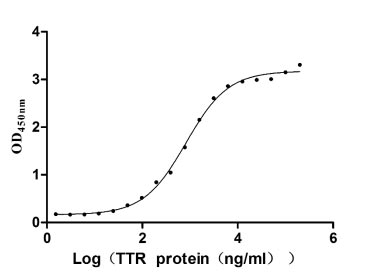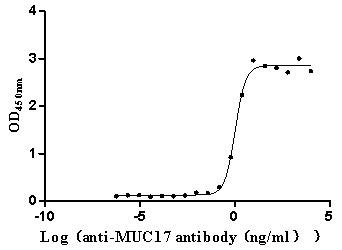Recombinant Mouse Occludin (Ocln), partial
-
货号:CSB-YP016263MO1
-
规格:
-
来源:Yeast
-
其他:
-
货号:CSB-EP016263MO1
-
规格:
-
来源:E.coli
-
其他:
-
货号:CSB-EP016263MO1-B
-
规格:
-
来源:E.coli
-
共轭:Avi-tag Biotinylated
E. coli biotin ligase (BirA) is highly specific in covalently attaching biotin to the 15 amino acid AviTag peptide. This recombinant protein was biotinylated in vivo by AviTag-BirA technology, which method is BriA catalyzes amide linkage between the biotin and the specific lysine of the AviTag.
-
其他:
-
货号:CSB-BP016263MO1
-
规格:
-
来源:Baculovirus
-
其他:
-
货号:CSB-MP016263MO1
-
规格:
-
来源:Mammalian cell
-
其他:
产品详情
-
纯度:>85% (SDS-PAGE)
-
基因名:
-
Uniprot No.:
-
别名:Ocln; Ocl; Occludin
-
种属:Mus musculus (Mouse)
-
蛋白长度:Partial
-
蛋白标签:Tag type will be determined during the manufacturing process.
The tag type will be determined during production process. If you have specified tag type, please tell us and we will develop the specified tag preferentially. -
产品提供形式:Lyophilized powder
Note: We will preferentially ship the format that we have in stock, however, if you have any special requirement for the format, please remark your requirement when placing the order, we will prepare according to your demand. -
复溶:We recommend that this vial be briefly centrifuged prior to opening to bring the contents to the bottom. Please reconstitute protein in deionized sterile water to a concentration of 0.1-1.0 mg/mL.We recommend to add 5-50% of glycerol (final concentration) and aliquot for long-term storage at -20℃/-80℃. Our default final concentration of glycerol is 50%. Customers could use it as reference.
-
储存条件:Store at -20°C/-80°C upon receipt, aliquoting is necessary for mutiple use. Avoid repeated freeze-thaw cycles.
-
保质期:The shelf life is related to many factors, storage state, buffer ingredients, storage temperature and the stability of the protein itself.
Generally, the shelf life of liquid form is 6 months at -20°C/-80°C. The shelf life of lyophilized form is 12 months at -20°C/-80°C. -
货期:Delivery time may differ from different purchasing way or location, please kindly consult your local distributors for specific delivery time.Note: All of our proteins are default shipped with normal blue ice packs, if you request to ship with dry ice, please communicate with us in advance and extra fees will be charged.
-
注意事项:Repeated freezing and thawing is not recommended. Store working aliquots at 4°C for up to one week.
-
Datasheet :Please contact us to get it.
相关产品
靶点详情
-
功能:May play a role in the formation and regulation of the tight junction (TJ) paracellular permeability barrier.
-
基因功能参考文献:
- PLD2 is pivotal in the regulation of the integrity of epithelial tight junctions and occludin turn over, thereby implicating it in the pathogenesis of colitis. PMID: 28484281
- Adherens as well as tight junction marker proteins were rapidly and consistently upregulated in both the germinal as well as the functional layer of the oral mucosa. This represents a previously unknown parameter of the epithelial radiation response to clinically relevant fractionation protocols. CONCLUSION: Fractionated irradiation significantly enhanced the expression of all proteins investigated. This study revealed a PMID: 29675597
- The C-terminal DSP domain induced phosphorylation of occludin Ser(490) and focal adhesion kinase (FAK) Ser(722) and Tyr(576). Coexpression of DSP, occludin and FAK was detected in dental mesenchymal cells during tooth development. Occludin physically interacts with FAK, and occludin and FAK phosphorylation can be blocked by DSP and occludin antibodies. PMID: 28331230
- Endothelial cellsTLR4 strongly regulates retinal vessel permeability by reducing expression of occludin and zonula occludens 1. PMID: 29136627
- The zinc sensing receptor, ZnR/GPR39, triggers intracellular Ca(2+) signalling in colonocytes thereby inducing occludin expression. Moreover, ZnR/GPR39 is essential for epithelial barrier recovery in the dextran sodium sulfate (DSS) ulcerative colitis model. PMID: 27377730
- Occludin expression by epidermal gammadelta T cells upon activation in response to epidermal stress allows them to move, which could be important for augmentation of immune responses via collaboration with other cells. PMID: 28566372
- Intracellular zinc has an essential role in the maintenance of the intestinal epithelial tight junction barrier through regulation of occludin proteolysis and claudin-3 transcription. PMID: 27151944
- miR-429 could down-regulate the expression of Ocln by targeting the Ocln 3'-UTR, which impaired intestinal barrier function in diabetes mellitus mice. PMID: 27299781
- STAT3 activation downregulates the ZO-1 and occludin levels and increases the endothelial permeability through the induction of VEGF production in retinal endothelial cells. PMID: 27580405
- Tricellulin is a specific redox sensor and sealing element at 3-cell contacts and may compensate as a redox mediator for occludin loss at 2-cell contacts in vivo and in vitro. PMID: 25919114
- These findings provide evidence for occludin playing a role in the invasion of Toxoplasma gondii in small intestinal epithelial cells. PMID: 26183539
- occludin deficiency increases susceptibility to ethanol-induced colonic mucosal barrier dysfunction and liver damage in mice. PMID: 26721332
- PHD3 protects intestinal epithelial barrier function and reveal a hydroxylase-independent function of PHD3 in stabilizing occludin PMID: 26124271
- Zonula occludens-1, occludin and E-cadherin expression and organization in salivary glands PMID: 25248927
- Our study demonstrates spatiotemporal alterations in occludin mRNA- and protein-expression, indicating that Cx43 might act as a regulator for blood-testis-barrier PMID: 24497041
- Occludin and Claudin-1 expressions in the large intestine are under the circadian control, which is associated with temporal regulation of colonic permeability and also susceptibility to colitis. PMID: 24845399
- Hypoxic induction of CAV1 in the colon was essential for intestinal barrier integrity by regulating occludin expression. PMID: 24891620
- Activation of RhoA/ROCK1 by high glucose in diabetic nephropathy disrupts the expression and translocation of occludin/ZO-1, which can be corrected by simvastatin. PMID: 24244596
- Similar levels of occludin gene expression were detected. PMID: 23568966
- actin cytoskeletal dynamics is detrimental to METH-induced BBB dysfunction by increasing internalization of occludin. PMID: 24081143
- Occludin showed identical mRNA expression levels in the brains of adult and aged mice. PMID: 22120415
- occludin KO gammadelta T cells are defective in both initial accumulation and migration within the intraepithelial compartment PMID: 22511722
- show that murine OCLN can sustain HCVcc entry, albeit with about 5-fold reduced efficiency compared to that of human OCLN PMID: 21632765
- Suggest occludin plays a crucial role in the maintenance of tight junction barrier through the large-channel TJ pathway, the pathway responsible for the macromolecule flux. PMID: 21415414
- The distribution patterns of tight junctions in ameloblasts by observing the expression patterns of OLD and CLDs (CLD-1 to CLD-10), were examined. PMID: 20683698
- The tight junction protein occludin (encoded by the OCLN gene) is involved in the pathogenesis of malformations of cortical development. PMID: 20727516
- Nedd4-2 interacts with occludin to inhibit tight junction assembly and the regulation of paracellular conductance in the collecting duct. PMID: 20504882
- marvelD3, occludin, and tricellulin define the tight junction-associated MARVEL protein family PMID: 20164257
- in vivo imaging and transgenic mice expressing fluorescent-tagged occludin and ZO-1 fusion proteins to link occludin endocytosis to TNF-induced tight junction regulation. PMID: 20351069
- suggest that occludin has a protective as well as a barrier forming role in epithelia. PMID: 20003227
- Surface plasmon resonance study of interaction of occludin with ZO-1 PMID: 11700038
- E-cadherin and claudins/occludin have roles in the regulation of tight junctions during the epithelium-mesenchyme transition, but are repressed by snail PMID: 12668723
- Data show that occludin is involved in establishing the blastocoel, in maintaining its impermeability, and that the development of tight junctions is critical for trophectoderm formation in mouse embryos. PMID: 15179038
- common molecular mechanism of forming a helical bundle between the hinge region/GuK domain of ZO-1 and alpha-catenin and occludin is identified as a general molecular principle organizing the association of ZO-1 at adherens and tight junctions PMID: 15548514
- Loss of occludin expression is at least partially involved in the senescence-escape program during mammary tumorigenesis. PMID: 17459053
- Amyotrophic lateral sclerosis-linked superoxide dismutase 1 (SOD1) mutants with different biochemical characteristics disrupted the blood-spinal cord barrier in mice by reducing the levels of the tight junction protein occludin. PMID: 18344992
- Describe method to study the intracellular transport of occludin to and from the cell surface in both fibroblasts and epithelial cells. PMID: 18369939
- In mouse cerebral cortex, microinjection of VEGF-A disrupted CLN-5 and OCLN and induced loss of barrier function PMID: 19174516
- the pro-inflammatory chemokine CCL2 mediates brain endothelial barrier disruption during CNS inflammation PMID: 19423710
- The oligomerization of the coiled coil-domain of occluddin is redox sensitive PMID: 19538283
- Disruptions of occludin and claudin-5 in brain endothelial cells in vitro and in brains of mice with acute liver failure. PMID: 19821483
显示更多
收起更多
-
亚细胞定位:Cell membrane; Multi-pass membrane protein. Cell junction, tight junction.
-
蛋白家族:ELL/occludin family
-
组织特异性:Localized at tight junctions of both epithelial and endothelial cells. Highly expressed in the testis, kidney, lung, liver and brain. Not detected in skeletal muscle, spleen and heart.
-
数据库链接:
KEGG: mmu:18260
STRING: 10090.ENSMUSP00000022140
UniGene: Mm.4807
Most popular with customers
-
Recombinant Human Retinol-binding protein 4 (RBP4) (Active)
Express system: Mammalian cell
Species: Homo sapiens (Human)
-
Recombinant Human Tumor necrosis factor ligand superfamily member 18 (TNFSF18), partial (Active)
Express system: Mammalian cell
Species: Homo sapiens (Human)
-
Express system: Mammalian cell
Species: Macaca fascicularis (Crab-eating macaque) (Cynomolgus monkey)
-
Recombinant Mouse Claudin-18 (Cldn18)-VLPs (Active)
Express system: Mammalian cell
Species: Mus musculus (Mouse)
-
Recombinant Human V-set and immunoglobulin domain-containing protein 4 (VSIG4), partial (Active)
Express system: Mammalian cell
Species: Homo sapiens (Human)
-
Recombinant Human Mucin-17 (MUC17), partial (Active)
Express system: Mammalian cell
Species: Homo sapiens (Human)
-
Recombinant Macaca fascicularis Trophoblast glycoprotein (TPBG), partial (Active)
Express system: Mammalian cell
Species: Macaca fascicularis (Crab-eating macaque) (Cynomolgus monkey)
-
Recombinant Human Claudin-6 (CLDN6)-VLPs, Fluorescent (Active)
Express system: Mammalian cell
Species: Homo sapiens (Human)





-AC1.jpg)



f4-AC1.jpg)










